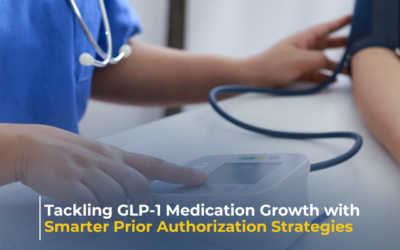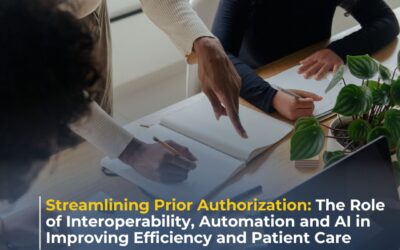In healthcare, regulatory oversight is constant. Organizations must demonstrate that grievance cases are resolved within mandated timelines, tracked appropriately, and documented with accuracy. The Centers for Medicare & Medicaid Services (CMS), for example, require health plans to follow strict turnaround times and maintain comprehensive records that can be reviewed during audits.
This means that grievance management cannot be treated as a one-size-fits-all process. The ability to automate and customize case workflows is increasingly essential to ensure both operational efficiency and regulatory readiness.
Key Takeaways:
- The healthcare industry faces ongoing challenges in streamlining prior authorization
- Automation, interoperability, and AI are critical to improving efficiency and patient care
- Modern solutions reduce administrative burdens for providers and payers
- Agadia’s technology supports faster, more accurate prior authorization processing
Why Automation is Important in Grievance Handling
Regulatory audits often focus on three critical areas:
- Timeliness – Were grievance cases acknowledged and resolved within required windows?
- Documentation – Is there supporting documentation to ensure complaints are properly recorded, categorized, and resolved?
- Oversight – Can managers monitor, adjust, and report on grievances in real time?
Automation directly supports each of these areas. By defining workflows that align with regulations and internal policies, organizations can ensure cases are managed consistently and within mandated timelines. Role-based responsibilities provide structure and accountability, while configurable dashboards and reporting give leadership clear visibility into performance. Automated reminders and escalation pathways further safeguard against missed deadlines, helping teams stay compliant without relying solely on manual tracking. Rather than forcing teams to adapt to rigid systems, configurable grievance case management allows organizations to design processes that align with both operational needs and evolving regulatory requirements.
Strengthening Oversight with Configurable Dashboards
One of the greatest risks in grievance management is a lack of visibility. Without clear oversight, delays or errors may go unnoticed until an audit is underway. Custom dashboards improve oversight by:
- Customizable Views: Dashboards can be tailored to show metrics relevant to specific roles (e.g. case worker, manager).
- Real-Time Visibility: Users can monitor grievance volumes, resolution timelines, and trends instantly, helping identify issues early.
- Proactive Reminders: Users are automatically alerted when a case deadline is approaching, and action is needed.
- Improved Decision-Making: Data-driven insights support faster, more informed decisions.
Together these features help organizations shift from reactive problem-solving to proactive oversight, driving greater efficiency and accountability in grievance management.
Audit Readiness Through Better Documentation
Audits require organizations to demonstrate not only that cases were resolved on time, but also how they were managed. Customized grievance systems can automatically produce case timelines, showing exactly when key actions occur. They can also generate reports that aggregate grievance data for regulatory agencies and create standardized documentation to ensure consistency across responses.
This level of documentation reduces human error and makes records both more reliable and easier to present during an audit. By maintaining a clear trail of evidence, grievance and compliance teams can approach audits with confidence, knowing their processes are both transparent and defensible.
Key features that strengthen documentation and support audit readiness include:
- Integration of Regulatory Requirements: Built-in fields, validations, and workflows aligned with CMS guidelines reduce the risk of missing required documentation.
- Standardizing Letters: A centralized template library ensures consistent documentation, supports compliance, boosts efficiency, reduces errors, and improves audit readiness.
- Centralized Repository: Secure storage of supporting evidence ensures everything is accessible during audits.
- Printable Full Case Report: Delivers a single, audit-ready document that captures the entire case history for review
Moving Toward Proactive Compliance
As regulatory requirements continue to evolve, health plans need systems that can adapt without requiring major process overhauls. Case work automation provides adaptability, ensuring grievance teams are not only prepared for audits but also capable of identifying risks before they escalate.
Ultimately, regulatory readiness is less about reacting to audits and more about building a framework that naturally produces compliant, transparent outcomes. Custom grievance case management is central to achieving that goal.
Solutions such as Agadia’s GrievancesHub are designed with this flexibility in mind, equipping organizations with the tools they need to configure workflows, maintain oversight, and remain audit-ready in an ever-changing regulatory environment.
If you would like to continue this conversation, please schedule some time with Agadia here.
About the author: Stephanie Abell

Stephanie Abell serves as Product Owner of GrievancesHub and as Compliance Specialist of PAHub at Agadia Systems, Inc. Her focus is on creating a solution for health plans and PBMS to help automate the grievance process as well as tracking regulatory compliance on prior authorizations and appeals.
Stephanie brings more than 18 years of experience with Medicare Advantage and Prescription Drug Plans. Prior to joining Agadia, she served as manager of Medicare products at a Blue Cross plan which included overseeing claims, enrollment, billing, grievances and CTMs. She was responsible for the selection, implementation, and oversight of multiple vendors including PBMs and TPAs. Stephanie managed the creation of member materials including summary of benefits, formularies, provider and pharmacy listings, ANOCs, EOCs, and CDAG and ODAG letters. She served as operations lead for CMS audits and supported the operational pieces of CMS bids.










